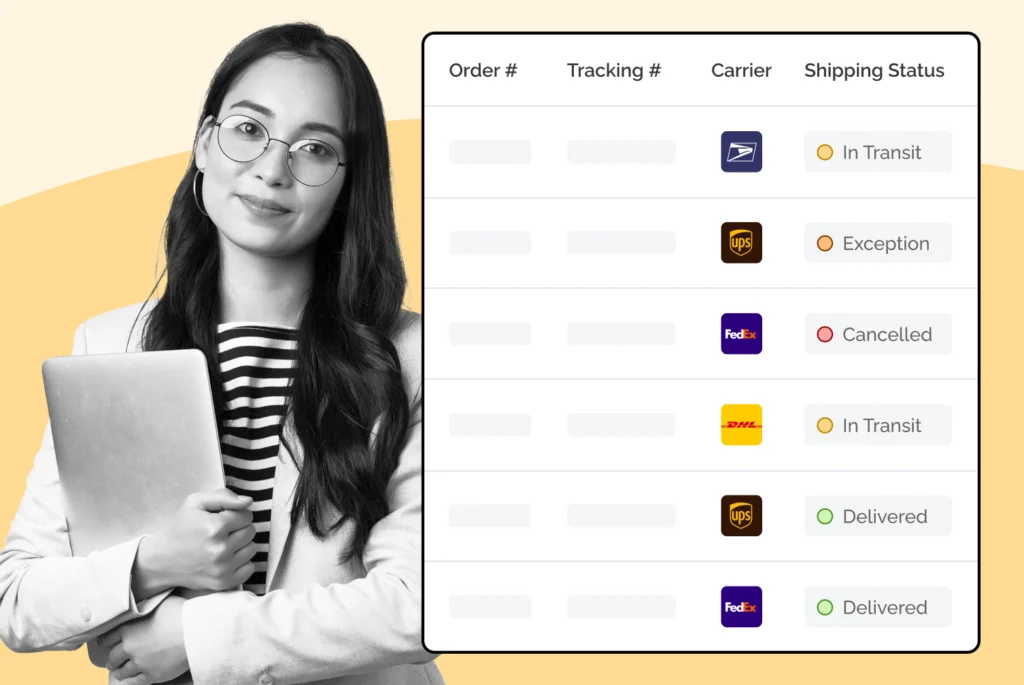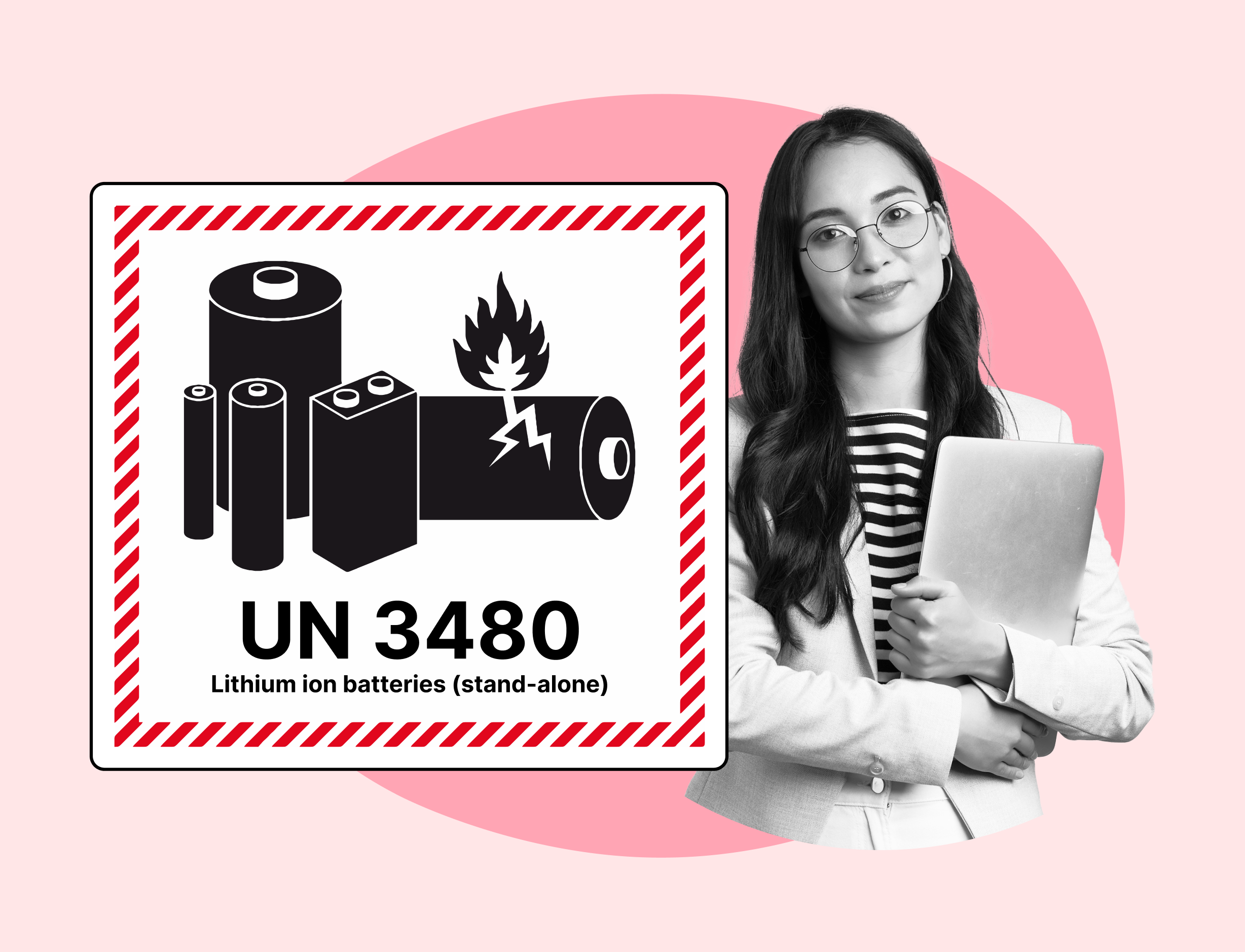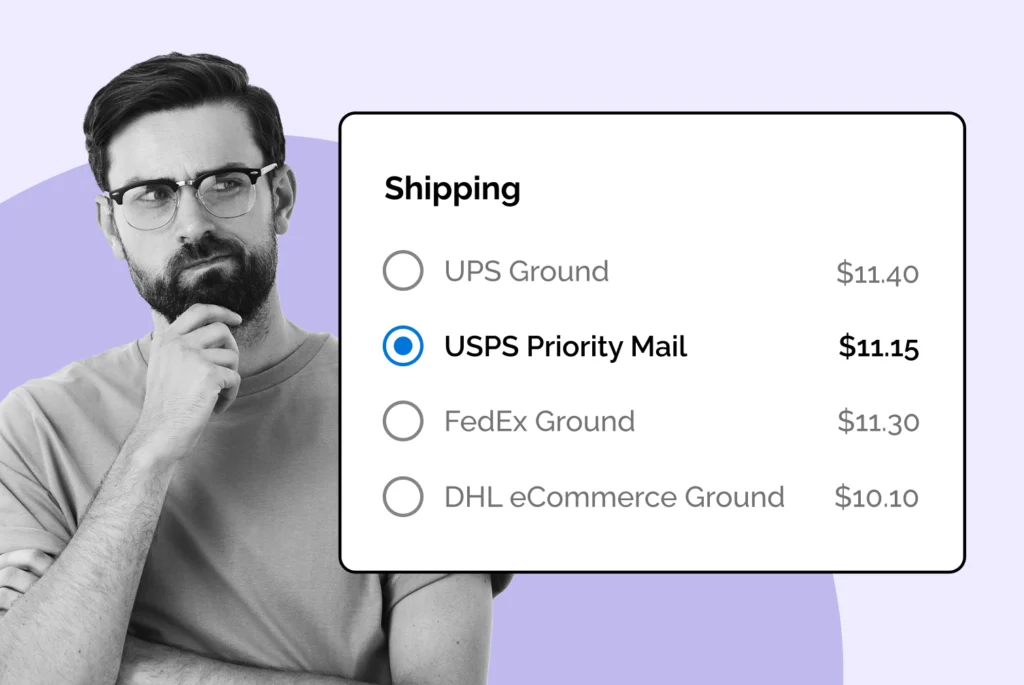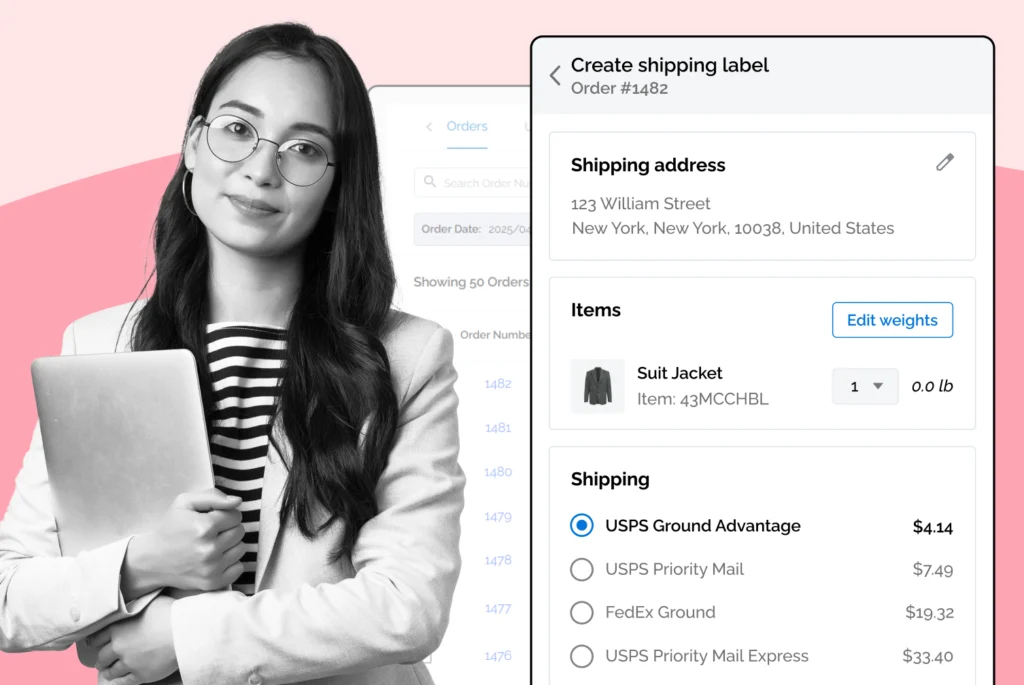
Multi-Carrier Shipping: Why It’s the Smart Choice for E-Commerce Logistics
Explore the key benefits of multi carrier shipping for your business. Enhance efficiency, cut costs, and improve customer satisfaction.
Shipping, Tracking & Notifications
Boost customer experience and reduce support tickets
Realtime order and shipment tracking
Proactive order and shipping notifications
AI-Enhanced Discounted Labels
Predictive pre-purchase estimated delivery dates
Self-Serivce branded order tracking
Effortless experience delivered
Identify and Resolve Order Issues
Realtime order and shipment tracking
Make returns profitable and delight customers
Flexibility to define any return destinations & conditions
Simplify returns for your customers and team
Incentivize exchanges over returns
Returns management made easy for your team
Returns management made easy for your team
Easy claims and smart upsells
Understand why your customers are returning
In-Store & Curbside Pickup
Unify the online and the in-store experience
Hassle-free pickup experience for customers
In-Store dashboard to keep operations streamlined
In-Store and Online orders unified
Drive foot-traffic to your stores
Shipping, Tracking & Notifications
Boost customer experience and reduce support tickets
Realtime order and shipment tracking
Proactive order and shipping notifications
AI-Enhanced Discounted Labels
Predictive pre-purchase estimated delivery dates
Self-Serivce branded order tracking
Effortless experience delivered
Identify and Resolve Order Issues
Realtime order and shipment tracking
Make returns profitable and delight customers
Flexibility to define any return destinations & conditions
Simplify returns for your customers and team
Incentivize exchanges over returns
Returns management made easy for your team
Returns management made easy for your team
Understand why your customers are returning
In-Store & Curbside Pickup
Unify the online and the in-store experience
Hassle-free pickup experience for customers
In-Store Dashboard to keep operations streamlined
In-Store and Online orders unified
Drive foot-traffic to your stores
Boost customer experience and reduce support tickets
Realtime order and shipment tracking
Proactive order and shipping notifications
AI-Enhanced Discounted Labels
Predictive pre-purchase estimated delivery dates
Self-Serivce branded order tracking
Effortless experience delivered
Make returns profitable and delight customers
Flexibility to define any return destinations & conditions
Simplify returns for your customers and team
Incentivize exchanges over returns
Returns management made easy for your team
Equip your team for precise return checks.
Easy claims and smart upsells
Understand why your customers are returning
Unify the online and the in-store experience
Hassle-free pickup experience for customers
In-Store Dashboard to keep operations streamlined
In-Store and Online orders unified
Drive foot-traffic to your stores
Find the answer to all your questions
Take a step by step trip through our functionality to see how we can improve your ecommerce processes.
Explore the most comon questions about WeSupply
Calculate the ROI that WeSupply can bring you
Read actionable articles on how to optimize your post-purchase experience and decrease support tickets
Get inspired by stories of how our customers implemented an effortless post-purchase experience
Wondering if WeSupply is a good fit for you? Read through our use cases to see how we can help you increase conversion & improve CX!
A Deep Dive into Top Companies' Order Tracking & Returns Strategy
Find the answer to all your questions
Explore the most comon questions about WeSupply
Calculate the ROI that WeSupply can bring you
Request a no strings attached review of your current shopping experience and missed conversion opportunities
Take a step by step trip through our functionality to see how we can improve your ecommerce processes.
Read actionable articles on how to optimize your post-purchase experience and decrease support tickets
Get inspired by stories of how our customers implemented an effortless post-purchase experience
A Deep Dive into Top Companies' Order Tracking & Returns Strategy
Wondering if WeSupply is a good fit for you? Read through our use cases to see how we can help you increase conversion & improve CX!

Shipping hazardous materials (often called hazmat) in ecommerce is one of the trickiest parts of running an online store. These materials include many everyday items like perfumes, nail polish, lithium batteries in electronics, cleaning sprays, or even dry ice used for food shipments. They are called hazardous not because they are always dangerous in normal use, but because under certain conditions such as heat, pressure, or breakage they can become unsafe.
Shipping dangerous goods requires strict compliance with international standards such as those set by ICAO and IATA, as well as carrier-specific regulations, to ensure safety and avoid legal penalties.
For online sellers, learning how to ship these products safely and legally is essential. Shipping hazmat items another term for shipping hazardous materials means following specific regulations for handling, packaging, and documentation. Mistakes don’t just risk accidents; they can also lead to serious fines, lost inventory, and even bans from carriers like FedEx, UPS, or USPS. In this guide, we’ll walk through everything you need to know about how to tackle hazardous material shipping in ecommerce step by step.
Hazardous materials are everywhere in ecommerce. Think of the lithium battery in your smartphone, the hairspray in your bathroom, or the nail polish you buy online. All of these count as hazmat because they can catch fire, explode, leak, or harm people if handled the wrong way. This makes customer safety a top priority, as proper handling and shipping protocols are essential to prevent risks to customers, personnel, and the environment.
The U.S. Department of Transportation (DOT) and its Pipeline and Hazardous Materials Safety Administration (PHMSA) reported that hazmat transportation accounts for more than 1.2 million shipments every single day in the U.S. Most arrive safely, but accidents do happen. In 2022, DOT recorded over 14,000 hazmat transportation incidents, many caused by improper packaging or labeling.
For ecommerce businesses, the stakes are high. Non-compliance can bring fines of up to $89,678 per violation per day, and in cases causing serious harm, penalties can exceed $250,000 plus possible jail time. Add to that the cost of damaged reputation or suspended carrier accounts, and it’s clear why compliance is not optional. Following hazmat shipping regulations not only protects your business but also improves customer satisfaction by ensuring safe and reliable delivery.
In the U.S., hazmat shipping is controlled mainly by the DOT and PHMSA, whose regulations are based on federal laws. These rules, published in Title 49 of the Code of Federal Regulations (49 CFR), cover classification, packaging, labeling, and paperwork. The Federal Aviation Administration (FAA) is also involved, especially for air shipments.
For international shipments, international regulations such as those from the International Civil Aviation Organization (ICAO) and the International Air Transport Association (IATA) govern air shipments. These organizations set dangerous goods regulations for the safe and compliant transportation of hazardous materials by air, with rules that are stricter than ground rules, especially for lithium batteries and flammable products. The International Maritime Dangerous Goods (IMDG) Code regulates hazardous materials moved by sea.
All of these requirements fall under the broader framework of hazmat regulations, which are designed to ensure dangerous goods shipping is conducted safely and in compliance with the law.
On top of this, each carrier has its own policies. For example, the United States Postal Service (USPS) only allows certain hazardous goods, and many can only move by ground. FedEx and UPS allow more, but require account approvals, training, and often charge extra handling fees. DHL requires pre-approval for hazardous shipments and adheres to consumer commodity guidelines for certain limited quantity hazardous materials. Carriers only accept ships hazardous goods classified according to their policies and regulatory requirements.
For an ecommerce seller, this web of regulations can feel overwhelming. But once broken into steps classify, package, label, document, and train dangerous goods shipping becomes much easier to manage.
The first step in hazmat shipping is figuring out what you are dealing with. Not all products are hazardous, but many common ecommerce goods fall into one of nine hazard classes defined by the DOT:
Explosives – like fireworks or ammunition.
Gases – such as propane, aerosols, helium tanks, or toxic gases like chlorine.
Flammable liquids – including perfumes, nail polish remover, and paints.
Flammable solids – like matches.
Oxidizers and organic peroxides – for example, hydrogen peroxide, oxidizing substances, and combustible materials such as ammonium nitrate.
Toxic or infectious substances – pesticides or medical samples.
Radioactive materials – certain medical isotopes.
Corrosives – bleach, drain cleaner, some batteries, and other corrosive substances.
Miscellaneous – items like lithium batteries, dry ice, magnetized materials, and other miscellaneous dangerous goods.
Common hazmat items in ecommerce include nail polish, perfumes, batteries, spray paint, and aerosol sprays.
The best way to classify your product is by using the Safety Data Sheet (SDS) or the Material Safety Data Sheet (MSDS) provided by your supplier or manufacturer. Section 14 of the SDS or MSDS lists the transport information, including the proper shipping name, UN identification number, hazard class, and packing group (I for most dangerous, II for moderate, III for lower risk). This helps determine if your product is a dangerous good that requires special handling.
Misclassification is one of the most common mistakes sellers make. Without correct classification, every step that follows packaging, labeling, paperwork will be wrong, which can mean delays, fines, or seized shipments.
All hazmat items must be properly classified before shipping.
Once classified, the next step is preparing the product for shipment. Packaging is about two things: safety and compliance.
Certain hazardous materials require special handling to comply with safety regulations, proper labeling, and specific packaging requirements. For example, shipping flammable liquids demands extra attention to packaging and strict adherence to compliance standards.
Hazmat must be packed in UN-specification packaging, sometimes called “performance-oriented packaging.” These containers are tested under tough conditions drops, stacking, vibration, and pressure to ensure they won’t fail during transit.
For ecommerce, this often means:
Inner containers (like bottles or cans) must be leak-proof.
Absorbent materials are required for liquids.
Outer boxes must be sturdy and meet minimum burst strength (200 lb. test for smaller packages).
For dry ice, packaging must allow gas to vent safely.
Lithium batteries must be insulated to prevent short circuits and kept away from other conductive materials.
Following the packaging manufacturer’s exact instructions is crucial. If you tape a box incorrectly or fail to use the right cushioning, the package may not meet compliance even if the box itself is certified.
Shipping flammable solids and liquids in ecommerce demands strict adherence to hazardous materials regulations and robust safety protocols. Flammable liquids such as nail polish, paint thinners, and certain cleaning products are classified as Class 3 hazardous materials, while flammable solids like matches and sulfur fall under Class 4. The Department of Transportation’s Pipeline and Hazardous Materials Safety Administration (PHMSA) sets out clear guidelines for the safe transport of these substances.
To ship hazardous materials like flammable liquids and solids, businesses must use proper packaging that meets UN performance standards, ensuring containers are leak-proof and resistant to rupture. Packaging labeling and documentation must accurately reflect the correct hazard class, proper shipping name, and identification number. For example, shipping nail polish requires marking the package as a flammable liquid and including the appropriate hazard label.
It’s essential to follow the materials safety administration PHMSA’s requirements for packaging, closure, and cushioning, as well as to provide clear handling instructions. Employees involved in shipping hazardous materials must be trained to recognize the risks and follow safety protocols, from initial packing to final delivery. Using shipping software that helps identify the correct hazard class and generates compliant shipping papers can greatly reduce the risk of errors.
By prioritizing proper shipping practices and compliance with hazardous materials regulations, ecommerce businesses can safely and efficiently ship flammable solids and liquids, protecting both their customers and their operations.
Shipping infectious substances such as medical waste, diagnostic samples, or laboratory specimens requires a heightened level of care and compliance. These materials are classified as Class 6 hazardous materials and are subject to some of the strictest federal regulations to ensure occupational safety and public health.
Businesses handling infectious substances must comply with the Department of Transportation’s hazardous materials regulations, as well as guidelines from the Centers for Disease Control and Prevention (CDC) and the Occupational Safety and Health Administration (OSHA). This means using specialized packaging that prevents leaks and withstands rough handling, and ensuring that all shipping papers and safety data sheets (SDS) are accurate and up to date.
Proper training is critical: employees must know how to safely handle, package, and ship infectious substances, and how to respond in case of a spill or exposure. Maintaining detailed records including SDS, shipping papers, and incident logs is not just a best practice, but a federal requirement.
By following these protocols, ecommerce businesses can ensure the safe and compliant shipping of infectious substances, minimizing risk to employees, carriers, and recipients.
After packaging, the outside of the shipment must be clearly marked so handlers and carriers know what’s inside.
This usually includes:
A diamond-shaped hazard label showing the hazard class (like a flame for flammables or skull and crossbones for toxins).
The proper shipping name and UN number (for example, “UN 1263 Paint”).
Orientation arrows if the package contains liquids.
Shipper and consignee names and addresses.
A shipping label that provides essential information for hazardous materials shipments, ensuring compliance, safety, and proper handling during transportation.
For small ecommerce shipments, the “Limited Quantity” exception may apply. This allows sellers to ship small amounts of certain hazardous materials with fewer requirements. The package is marked with a black-and-white diamond instead of full hazard labels. This option can save money and time, but only applies under specific limits. Proper documentation must still accompany all labeled packages to ensure regulatory compliance and safe handling.
Remember: hazard labels must be purchased from authorized suppliers. You can’t hand-draw them or print them in the wrong size.
Paperwork is the backbone of hazmat compliance. Without the right documents, carriers won’t accept your package.
For ground shipments in the U.S., you’ll need a shipping paper often a Bill of Lading that lists:
UN number
Proper shipping name
Hazard class
Packing group
Quantity and number of packages
A 24/7 emergency contact number
Emergency contact information
For air shipments, you’ll often need a Shipper’s Declaration for Dangerous Goods, which is more detailed and required for all dangerous goods shipments. Sea shipments follow similar rules under the IMDG code.
Some carriers also require a copy of the SDS to be provided.
For ecommerce businesses handling many orders, hazmat-compliant shipping software like Easyship, ShipBob, or Shippo can automatically generate the required paperwork, reducing errors and saving time.
Shipping hazmat across borders adds another layer of complexity. You’ll need to follow both U.S. rules and international regulations, as well as the rules of the destination country.
Air shipments must comply with IATA and the International Civil Aviation Organization (ICAO), while sea shipments must follow the IMDG code. Beyond that, customs documents such as a commercial invoice or certificate of origin may also be required.
When you ship dangerous goods internationally, major carriers require strict compliance with both U.S. and international rules and procedures.
It’s also important to remember that some countries ban specific hazardous products altogether. For example, many countries heavily restrict importing lithium batteries. Always confirm destination rules before sending international hazmat shipments.
Returns Analytics for eCommerce Business
Book a quick call with our experts to see how WeSupply can help you understand why your customers are returning: Identify the most returned products, Understand why those products are returned, Identify which customers are serial returners, Reduce Return Rate with Actionable Insights, Returns data available in BigQuery.
Not every carrier will accept every hazmat shipment. The United States Postal Service, for example, prohibits many hazardous items and only allows certain products by ground, with strict restrictions on what can be shipped. UPS and FedEx have broader services but require account approval and may charge extra handling fees (often between $45 and $160 per package). DHL specializes in international hazmat shipments but also has strict limits DHL requires pre-approval for hazardous shipments and adheres to consumer commodity guidelines for certain limited quantity hazardous materials.
Carriers only accept ships hazardous goods classified according to their policies and regulatory requirements.
If you use a third-party logistics provider (3PL), make sure they are equipped to handle hazardous goods. Many fulfillment centers refuse hazmat because of the added complexity and risk. Always ask about certifications, training, and experience before choosing a partner.
The DOT requires that anyone who handles hazardous materials shipments whether classifying, packaging, labeling, or preparing paperwork must receive hazmat training at least once every three years.
This training covers:
General awareness of regulations
Security awareness
Safety measures
Function-specific tasks (like packaging or paperwork)
Carriers like UPS and FedEx often provide free webinars and resources. Many online training providers also offer certification programs that ecommerce businesses can complete at their own pace.
Training is not just a box to check it helps prevent costly mistakes and ensures everyone on your team understands their responsibilities.
Before a package even leaves your warehouse, proper handling and storage are essential.
Hazmat materials should be stored separately from each other if they might react together for example, keeping flammable products away from oxidizers or corrosives. Packaging should be inspected for leaks or damage before shipping.
SDS and Material Safety Data Sheets (MSDS) should be available in your warehouse to guide safe handling. Training employees on what to do in case of a spill or accident adds another layer of protection.
Security is also a concern. Some hazardous products, such as chemicals, can be misused if stolen. Strong inventory controls and secure storage reduce risks.
Hazmat shipping is almost always more expensive and time-consuming than regular shipping. Carriers add surcharges, transit may be limited to ground (slowing delivery by several days), and packaging requirements can increase costs.
Common mistakes ecommerce sellers make include:
Misclassifying products (thinking nail polish is “just liquid” when it’s actually a flammable).
Forgetting orientation arrows for liquids.
Using non-certified packaging.
Not disclosing hazmat to carriers, which can lead to seized shipments.
Understanding and planning for these challenges can help keep your operations smooth and compliant.
The penalties for hazmat violations are no small matter. PHMSA can fine businesses up to $89,678 per violation per day, and if the violation leads to injury, death, or major environmental harm, fines can exceed $250,000 and include imprisonment.
In 2016, a company was fined $150,000 for shipping undeclared lithium batteries by air after one caught fire in transit. Such cases show how quickly things can go wrong when regulations are ignored.
For ecommerce businesses, even a single violation can ruin customer trust and damage your reputation.
The most successful ecommerce businesses shipping hazmat follow these best practices:
Always start with accurate SDSs from suppliers.
Use approved packaging and follow closure instructions carefully.
Label and mark packages correctly every time.
Keep thorough records of training, documentation, and audits.
Ensure you are shipping dangerous goods safely by following all regulations and safety protocols to prevent accidents and maintain compliance.
Consider using “Limited Quantity” rules to simplify smaller shipments.
Partner only with carriers and fulfillment providers experienced in hazmat.
Technology can make hazmat compliance much easier. Shipping software can auto-fill documents, print proper labels, and flag errors before they become costly. Some platforms also track changes in carrier or regulatory rules.
Insurance is another critical tool. Even with perfect compliance, accidents can happen. Hazmat insurance can protect your business from financial losses due to spills, fires, or legal claims.
The world of hazmat shipping is rapidly evolving, with new technologies and practices making it easier and safer to ship hazardous materials. One major trend is the adoption of digital platforms and shipping software that automate key steps such as classifying hazardous goods, generating compliant labels, and preparing documentation. These tools help businesses ship hazardous materials with greater accuracy, reducing the risk of costly mistakes and regulatory violations.
Another trend is the shift toward alternative transportation modes, like rail and sea, for shipping hazardous materials. These options can offer safer and more environmentally friendly alternatives to road or air, especially for large or international shipments.
Advancements in packaging technology are also making a difference. New absorbent materials and specialized containers are designed to prevent leaks and spills, even under extreme conditions. These innovations help ensure that businesses can ship hazardous materials safely, protecting both people and the environment.
By staying informed about these trends and adopting new technologies, ecommerce businesses can streamline their hazmat shipping processes and maintain compliance in an ever-changing regulatory landscape.
Hazmat shipping regulations are continually being updated to address new risks and improve safety. One of the most significant recent changes involves the transportation of lithium ion batteries, which are now subject to stricter testing, packaging, and labeling requirements due to their potential to ignite or explode. The Department of Transportation (DOT) and the International Air Transport Association (IATA) have both introduced new rules to ensure these hazardous materials are shipped safely.
There is also a growing regulatory focus on the use of alternative fuels and eco-friendly transportation methods, such as electric and hybrid vehicles, to reduce the environmental impact of hazmat shipping. Additionally, emerging technologies like blockchain and artificial intelligence are being explored to enhance real-time tracking, monitoring, and documentation of hazmat shipments, further improving safety and compliance.
Businesses must keep up with these evolving regulations, especially when shipping toxic and infectious substances or radioactive materials. Staying informed and adapting to new rules is essential for maintaining compliance, avoiding fines, and ensuring the safe transport of hazardous materials in a changing world.
Stay Compliant with Evolving Hazmat Shipping regulations
Book a quick call to see how WeSupply helps you stay compliant and safe with hazmat shipping.
Combat inconvenience with proactivity & self service
Book a quick call with our experts to see how WeSupply can help you make returns easy for your customers with a beautiful, self-service solution that makes their experience easier while also providing new ways to lower costs and earn back revenue.
Shipping hazardous materials isn’t just about getting a package from point A to point B, it’s about doing it safely, responsibly, and with complete visibility at every step. That’s where WeSupply steps in. Our platform makes the complex world of hazardous materials shipping easier to manage, giving businesses the tools they need to protect both customers and compliance.
Here’s how WeSupply helps:
Proactive Problem Solving – Identify delays, undeliverable shipments, or stalled packages before they become major issues and take action fast.
Customer Communication Made Simple – Automatically notify customers about shipping updates, delays, or safety concerns so they stay informed without you lifting a finger.
Lost or Stolen Package Support – Quickly resolve lost or mishandled hazardous shipments with an easy claims process and rapid re-shipping solutions.
Complete Oversight – See the full journey of every shipment in one place, making compliance reporting and safety checks effortless.
Customizable Safety Workflows – Adapt WeSupply’s workflows to fit your hazardous shipping needs, ensuring every regulation and precaution is met.
By combining visibility, communication, and proactive management, WeSupply turns one of the trickiest parts of ecommerce hazardous materials shipping into a process you can trust and scale.
🚀 Ready to make hazardous materials shipping safer for your business and your customers? Schedule a demo with WeSupply today!
Shipping hazardous materials in ecommerce doesn’t have to be overwhelming when you have the right tools in place.
With WeSupply, you gain real-time shipment tracking across 1,000+ carriers, instant visibility into delays or stalled packages, and proactive communication that keeps customers informed every step of the way. From resolving lost or undeliverable shipments to simplifying compliance workflows and ensuring every package reaches its destination safely, WeSupply turns complex hazmat shipping into a manageable, customer-first process. By centralizing all shipment data, automating updates, and empowering your team to respond quickly, WeSupply helps you avoid costly errors, protect your profits, and deliver the peace of mind your customers deserve. Safe shipping isn’t just compliance it’s building trust.
With WeSupply, your ecommerce business can confidently grow, even in the challenging world of hazardous materials.
1. Why is hazmat shipping compliance important for ecommerce?
Compliance prevents accidents, fines, and carrier bans. Violations can cost up to $250,000, damage reputation, and even lead to jail time. Safe hazmat shipping protects businesses, customers, and the environment.
2. How do I know if my product is hazardous?
Check the product’s Safety Data Sheet (SDS), especially Section 14. It lists hazard class, UN number, and packing group. Misclassification leads to fines, delays, and seized shipments.
3. Which carriers allow hazardous materials shipping?
UPS and FedEx allow many hazmat items with approval and fees. USPS permits limited goods via ground. DHL specializes in international hazmat but requires pre-approval. Always confirm carrier policies before shipping.
4. How does WeSupply help with hazardous materials shipping?
WeSupply provides real-time tracking, compliance oversight, and proactive alerts. It helps ecommerce businesses ship hazardous materials safely while simplifying documentation, safety checks, and customer communication.
5. Can WeSupply reduce hazmat shipping risks?
Yes. WeSupply identifies delays, lost shipments, and compliance gaps early. Its customizable safety workflows keep hazardous shipments compliant, preventing costly errors and protecting customer trust.
6. Why choose WeSupply for hazmat shipping management?
WeSupply centralizes shipment tracking across 1,000+ carriers, automates compliance workflows, and simplifies customer notifications. This ensures hazardous goods arrive safely, on time, and with full visibility.
7. Does WeSupply have an Official Shopify App?
Yes. WeSupply has an Official Shopify App. You can download it and start integrating with your Shopify Store.
8. Does WeSupply have an official Magento extension?
Yes, WeSupply has an official extension for Magento. The WeSupply x Magento integration allows for automating order tracking experiences, reducing customer inquiries, automating shipping email and SMS notifications, and providing a fully branded order tracking experience
9. Does WeSupply have an official BigCommerce App?
Yes, WeSupply has an official BigCommerce App. You can integrate WeSupply with your BigCommerce store to improve your post-purchase customer experience.
Learn How To Create Successful Post Purchase Email Campaigns
Build an effective post-purchase email flow that helps you increase customer satisfaction and drive revenue growth!
To stay ahead during the busiest times, use multi carrier shipping software to automate rate comparisons, track carrier performance, and adjust your shipping strategy as needed. By avoiding these common mistakes, your business can achieve long-term success, keep costs under control, and deliver a superior customer experience throughout every peak season.

Explore the key benefits of multi carrier shipping for your business. Enhance efficiency, cut costs, and improve customer satisfaction.

Discover the true costs of overnight shipping as we compare rates and options. Make informed choices for your shipping needs.
Discover top real-time package tracking solutions for seamless shipping experiences. Improve your logistics today!

Discover top shipping API solutions that enhance your ecommerce fulfillment process. Simplify logistics and improve customer satisfaction.

Master post-holiday returns management with effective strategies that streamline processes and enhance customer satisfaction.

Discover the pros and cons of flat rate and standard shipping to make the best choice for your needs. Read the article now!

Boost holiday sales with AI-driven recommendations this BFCM. Discover strategies to engage customers and increase conversions.

Discover essential strategies to streamline bulk returns handling and enhance efficiency. Read the article for practical tips!

Learn how to accurately calculate shipping costs with our essential guide. Get practical tips and tools to ensure your estimates are spot on.